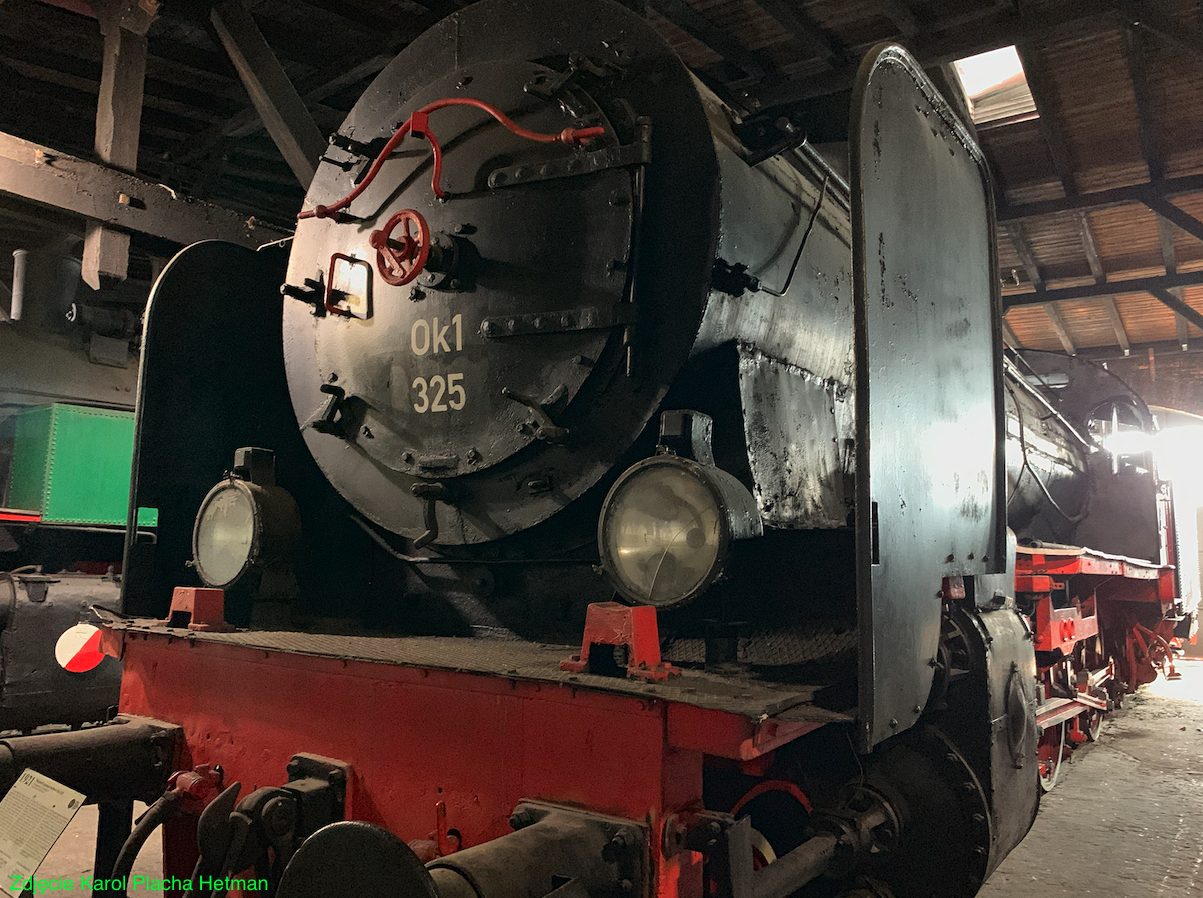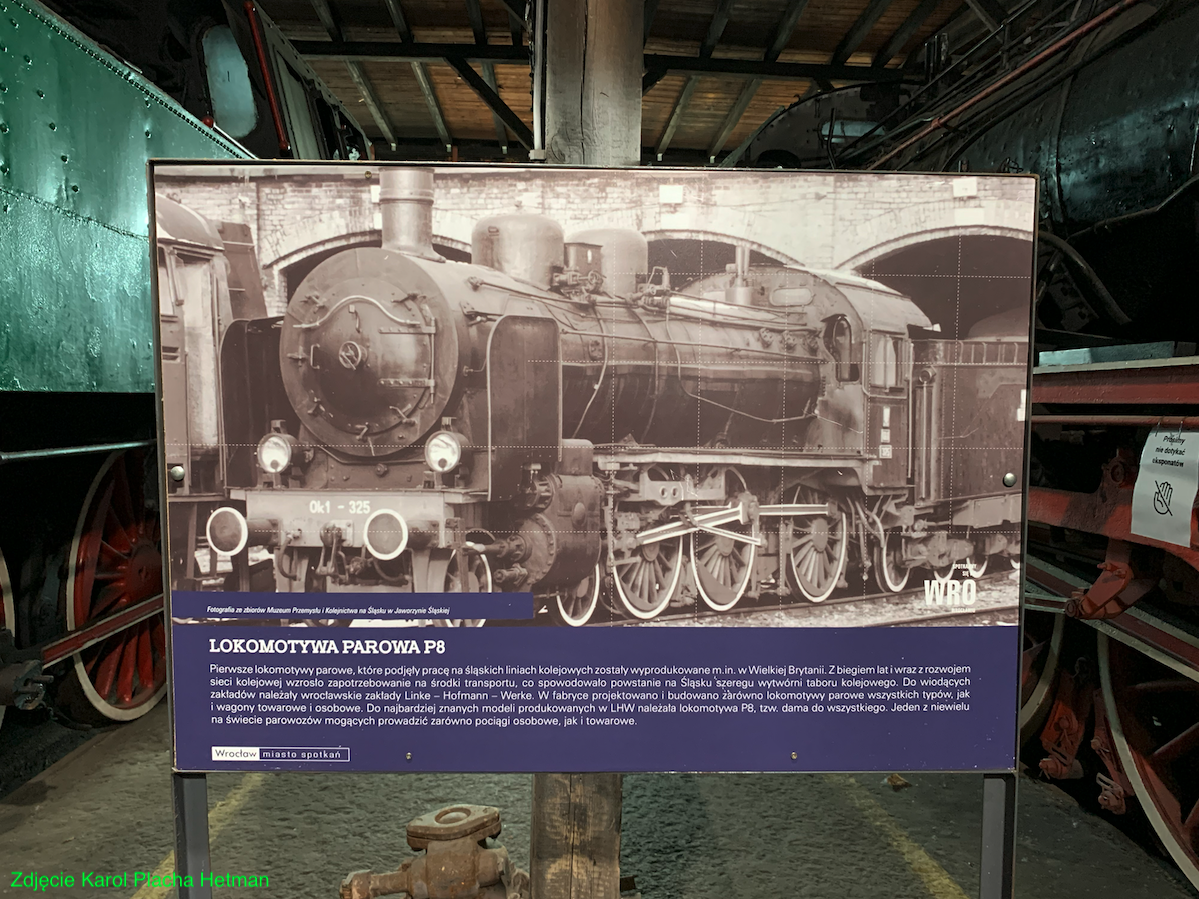Jaworzyna Śląska 2023-08-16
Steam Locomotive Ok1.
The steam locomotive marked in PKP type Ok1, that is the Prussian type P8, a very popular locomotive used both in passenger and freight trains. The locomotives were produced by many factories. Generally, production lasted from 1906 to 1923, but locomotives were still built for some customers until 1939. Because the P8 (Ok1) steam locomotives were built in different factories, their technical data differed.



The P8 locomotive was built at the beginning of the 20th century for the needs of the Prussian-Hessian State Railways (Preußisch-Hessische Staatseisenbahnen). The two-axle P4 and S7 locomotives used so far were too weak. The new S10 series locomotives were good, but too expensive to produce and operate. Therefore, engineer Robert Garbe was commissioned to develop a new locomotive. Engineer Robert Garbe designed the locomotive in 1905, based on his previous design of the P6 series, as a locomotive that could pull fast and light freight trains. The design speed of the prototypes was 110 km/h. He used the same axle arrangement as in the P7 series locomotives, i.e. 2'C (2-3-0). The motors drive the second coupled axle. All drive axles are rigidly mounted in the frame. In order for the locomotive to negotiate tight curves, the flanges of the first axle have been reduced. A narrow firebox was used, which was made of copper. The box is placed between the sole bar, which is its disadvantage, because it limits its dimensions. The locomotive uses a twin engine with a flame tube steam superheater of the Schmidt design. The steam distribution is carried out using the Walschaerts (Heusinger) joint.
10 pre-series P8 locomotives were built. Their tests resulted in changes. The area of the boiler superheater has been increased. The capacity of the tender has been increased. Speed reduced from 110 km/h to 100 km/h. The pointy canopy, which was supposed to reduce air resistance, was abandoned. Brakes were also installed on the rolling bogie. From 1926, small Wagner windchests began to be assembled. In 1907, 7 more locomotives were built in the Vulcan factory in Szczecin. In 1908, serial production began, simultaneously in different factories. Therefore, individual production series had differences in performance. There were different versions of boilers, their heating surfaces and superheaters.
Type Ok1 is the Polish designation for PKP, a passenger locomotive of the Prussian P8 series. After the Great World War, 257 Ok1 locomotives were operated in Poland, and as many as 429 after the Second World War. The locomotives were mass-built in several Germanic factories. 3,960 locomotives were built. After the Great World War, the Germans changed the designation of the locomotive to the 38 series.
When Poland regained its independence, it received 190 Ok1 locomotives (number Ok1-1 to Ok1-190) as war reparations, and two locomotives Ok1-1Dz and Ok1-2Dz, for the Wole Miasto Gdańsk. Subsequently, 65 new locomotives were ordered for PKP from German factories, which were marked Ok1-201 to Ok1-265, and which were built in the period 1922-1923 at the Hanomag factory, Linke-Hofmann. In 1939, stupid Germans started World War II. As a result, they lost a lot of land, property and image. Polish locomotives were plundered by the Germans and their Muscovite brothers. After 1945, PKP had 429 locomotives, which were re-marked with numbers from Ok1-1 to Ok1-429. It was the largest group of locomotives in PKP in the second half of the 40s. Many of them were still in operation in the 70s. Several copies have been preserved for museum purposes, among others: in Żagań (Ok1-198), in Skierniewice (Ok1-266), in Jaworzyna Śląska (Ok1-325).
The Ok1 steam locomotive was one of the most successful. It was used to service passenger and freight trains. It had good traction properties, smooth running, low failure rate and ease of use. The Ok1 locomotive could pull passenger trains with 4-axle wagons weighing 295 tons at a speed of 100 km/h, or freight trains weighing 645 tons at a speed of up to 80 km/h on a horizontal track. The locomotive with a freight train of 400 tons, on an elevation of 10‰, reached a speed of 70 km/h.
T-T data of Ok1 locomotive:
Ok1 has an axis system of 2'C. Curb weight 71,700 kg. Curb weight of the last production series 76,100 kg. Service weight 78,200 kg. Length 11.20 m. Length with tender 18.60 m. Height 4.55 m. Distance between outer axles 15.66 m. Diameter of driving wheels 1.75 m. Diameter of rolling wheels 1.00 m. Tender type 22D2. Pressure in the boiler 12 at. Heating area of the boiler is 143.25 square meters. Superheater area 52 square meters. Grid area 2.64 square meters. Power 900 hp (662 kW). Maximum tractive force 12,500 kG. Design speed 100 km/h, and for prototypes 110 km/h. Axle load from 15,900 kg to 17,000 kg in the latest series versions.
Written by Karol Placha Hetman
